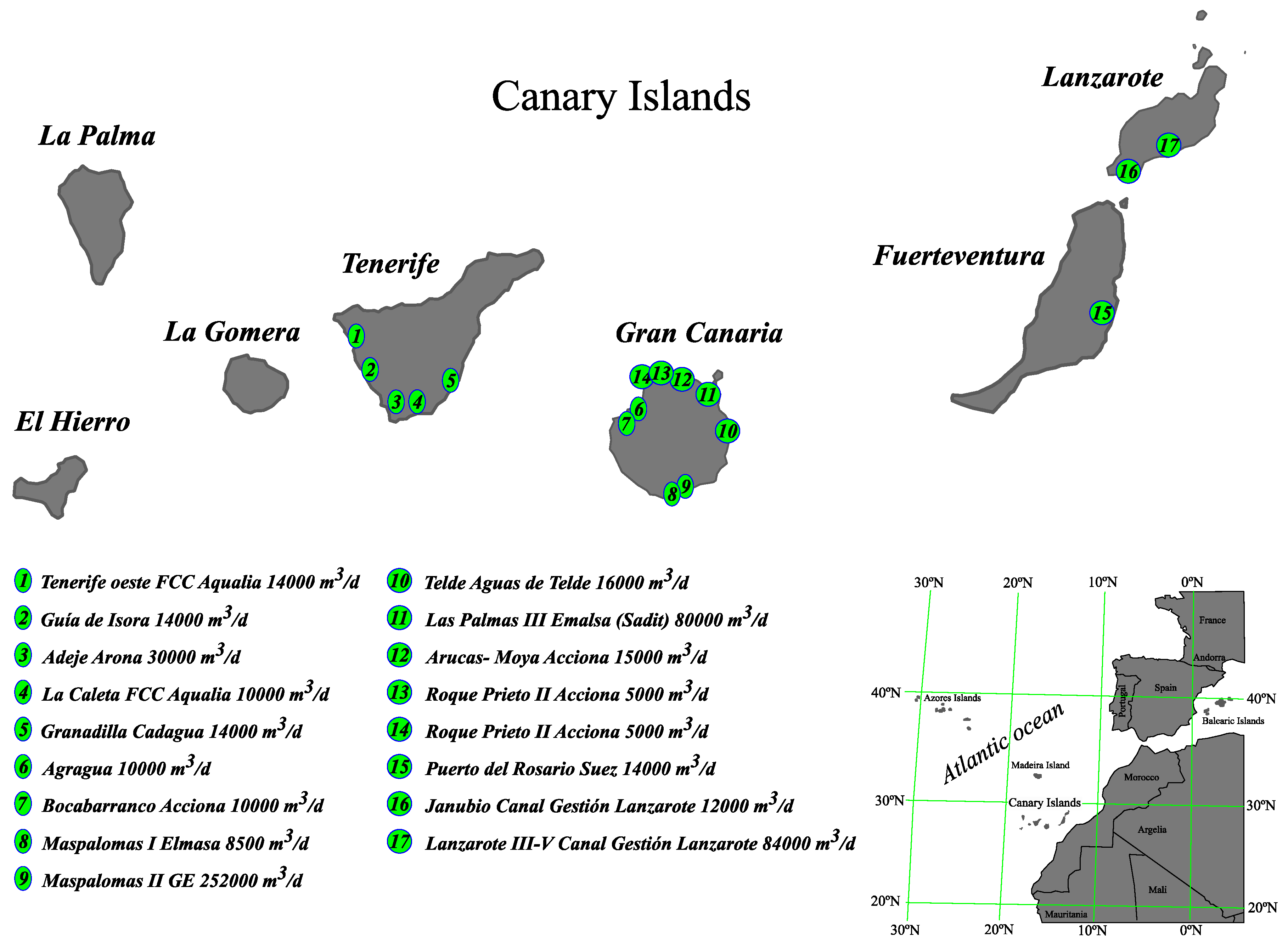Study for Recycling Water Treatment Membranes and Compnents towards a Circular Economy—Case of Macaronesia Area
Abstract
1. Introduction
- To remove salt precipitates, an acid solution (hydrochloric, phosphoric or critical acid) and agents such as EDTA.
- To remove sediments and organic compounds, alkaline solutions combined with surfactants.
- To eliminate micro-organisms, chlorine solutions and chlorine derivatives to sterilize membranes.
2. Technical Actions to Be Carried Out
2.1. State-of-the-Art Recycling of Reverse Osmosis Membranes in Maccaronesia
2.1.1. Types of RO Membranes
2.1.2. Membrane Materials
2.1.3. Recycling of RO Membranes
2.1.4. Pyrolysis Process
2.1.5. Other Options for Disposal
3. Results and Discussions
4. Conclusions
Author Contributions
Funding
Institutional Review Board Statement
Informed Consent Statement
Data Availability Statement
Conflicts of Interest
Appendix A
| Staff | €/year | €/year | €/m3 |
| 1 Plant Manager | 50,485.01 | ||
| 1 Administrative | 22,357.65 | ||
| 1 Maintenance Manager | 36,781.94 | ||
| 2 Mechanical Maintenance | 55,894.12 | ||
| 2 Electric Maintenance | 55,894.12 | ||
| 5 Operators | 139,194.40 | ||
| Total staff | 360,607.24 | 0.0203 | |
| FIXED COSTS | |||
| (a) Exploitation | |||
| Laboratories | 9255.58 | ||
| Sampling consumables | 1320 | ||
| Stationery | 3970 | ||
| Phone and mail | 6611.13 | ||
| Clothing and work clothes | 3331 | ||
| Security expenses | 2640 | ||
| Civil liability insurance (multi-risk) | 13,222.26 | ||
| Rent a car | 4960 | ||
| Total exploitation | 45,309.97 | 0.0025 | |
| (b) Maintenance | |||
| Mechanic | 19,833.39 | ||
| Electric | 9916.69 | ||
| Oils and fats | 30,300.00 | ||
| Workshop spare parts | 26,400.00 | ||
| Various repairs | 15,000.00 | ||
| Potable water | 1000 | ||
| High voltage network maintenance | 1320 | ||
| Third party contracts | 79,333.59 | ||
| Training | 5000 | ||
| Total maintenance | 188,103.67 | 0.0106 | |
| (c) Conservation | |||
| Paintings | 4630 | ||
| Gardening | 6611.13 | ||
| Cleaning | 1980 | ||
| Masonry | 1320 | ||
| Miscellaneous (security, pest control, etc.) | 14,544.49 | ||
| Total conservation | 29,085.62 | 0.0016 | |
| TOTAL FIXED COSTS (a + b + c) + STAFF | 623,106.50 | 0.035 | 8% |
| VARIABLE COSTS | |||
| (d) Pretreatment reactives | |||
| Coagulant | 595,001.98 | ||
| Polyelectrolyte | 165,278.32 | ||
| Sodium hypochlorite | 330,556.65 | ||
| Sodium bisulfite | 0.00 | ||
| Anti-scalant | 231,389.66 | ||
| Sulfuric acid | 0.00 | ||
| Total pretratment reactives | 1,322,226.61 | 0.0743 | |
| (e) Post-treatment reactives | |||
| Sodium hypochlorite | 0.00 | ||
| Calcite (25 g/m3 at 60 €/ton) | 6,700.00 | ||
| CO2 (10 g CO2/m3 a 0.6 €/kg incl. rent + replace) | 106,800.00 | ||
| Total post-treatment reactives | 133,500.00 | 0.0075 | |
| (f) Membrane cleaning | 33,055.67 | 33,055.67 | 0.0019 |
| (g) Cartridge replacement (15,000 cart. × 15 €/cart.) | 247,500.00 | 247,500.00 | 0.0139 |
| (h) Membrane replacement (10% at 700 €/unit) | 1,884,960 | 1,884,960 | 0.1059 |
| TOTAL VARIABLE COSTS (d + e + f + g + h) | 3,621,242.30 | 0.2034 | 47% |
| FIXED COSTS + STAFF + VARIABLES COSTS | 0.2384 | 55% | |
| GENERAL EXPENSES + INDUSTRIAL PROFIT | 0.0453 | 10% | |
| EXPLOITATION COSTS | 0.2838 | 65% | |
| ENERGY (3.1 kW/h m3 at 0.049 €/kW/h) | 2,703,820.00 | 0.1519 | 35% |
References
- Kurihara, M. Seawater Reverse Osmosis Desalination. Membranes 2021, 11, 243. [Google Scholar] [CrossRef] [PubMed]
- Ruiz-García, A.; Melián-Martel, N.; Nuez, I. Short Review on Predicting Fouling in RO Desalination. Membranes 2017, 7, 62. [Google Scholar] [CrossRef]
- Jorge, S.; Patricia, T.; Carlos, M. Reúso de aguas residuales domésticas en agricultura. Una revisión. Rev. Agron. Colomb. 2008, 26, 347–359. [Google Scholar]
- World Health Organization (WHO). WHO guidelines for the safe use of wastewater, excreta and greywater. In Volume II: Wastewater Use in Agricultura; WHO: Paris, France, 2006; 222p. [Google Scholar]
- WHO. “World Health Organization—Water”, Fact Sheet 391. Available online: http://www.who.int/mediacentre/factsheets/fs391/en/2014 (accessed on 5 August 2014).
- Quist-Jensen, C.A.; Macedonio, F.; Drioli, E. Membrane technology for water production in agricultura: Desalination and wastewater reuse. Desalination 2015, 364, 17–32. [Google Scholar] [CrossRef]
- Francisco, J.; García, L.; Sebastián, O.; Pérez, B.; Antonio, G.G. Energy performance of a RO desalination plant operating with variable pressure and flow. Desalination 2015, 366, 146–153. [Google Scholar] [CrossRef]
- Kheriji, J.; Mnif, A.; Bejaoui, I.; Hamrouni, B. Study of the influence of operating parameters on boron removal by a RO membrane. Desalination Water Treat. 2015, 56, 2653–2662. [Google Scholar] [CrossRef]
- Schallenberg-Rodríguez, J.; Veza, J.M.; Blanco-Marigorta, A. Energy efficiency and desalination in Cape Verde. Renew. Sustain. Energy Rev. 2014, 40, 741–748. [Google Scholar] [CrossRef]
- Zerpa, F.L.; Pérez, A.R. Low-Cost Continuous Measurement System to Determine the Relationship between the Electrical Conductivity “Ec” and the Temperature “T” in Brackish Waters. DYNA 2021, 96, 364–367. [Google Scholar] [CrossRef]
- Joaquín, B.M.; Valenti, J.V. Geografía De España; Ariel: Barcelona, Spain, 1990. [Google Scholar]
- Available online: https://administracion.gob.es/pag_Home/espanaAdmon/comoSeOrganizaEstado/ComunidadesAutonomas.html (accessed on 31 May 2021).
- Guillermo, M.M. Las Islas Canarias ¿Una Región Aislada?” 2001, Boletín de la A.G.E. N.32: 155. Available online: https://e-archivo.uc3m.es/handle/10016/13217 (accessed on 31 May 2021).
- Parlamento Europeo. Tratado De Funcionamiento De La Unión Europea (TFUE). Artículos 349 Y 355; Las Regiones Ultraperiféricas (Rup); Fichas Técnicas Sobre La Unión Europea; Parlamento Europeo: Strasbourg, France, 2016.
- Zerpa, F.L.; Suarez, B.P.; Filgueira, F.J.R.; Vaswani, J. Reuse of Reverse Osmosis Elements of the Desalination Processes. DYNA 2021, 96, 429–434. [Google Scholar] [CrossRef]
- Instituto Nacional de Estadística. Demografía y Población, Estadísticas de Nacimientos, Muertes Fetales y Neonatales. 2019. Available online: http://www.ine.es (accessed on 15 July 2019).
- Gamero, B.D.R. Mitigación del Cambio Climático en el Ciclo Integral del Agua: Aplicación al Proceso de Trata-Miento de Aguas Residuales. Ph.D. Thesis, Universidad de Las palmas de Gran Canaria, Las Palmas, Spain, 2018. [Google Scholar]
- Veza, J.M.; Rodriguez-GonzalezJuan, J. Second use for old RO membranes: Wastewater treatment. Desalination 2003, 157, 65–72. [Google Scholar] [CrossRef]
- Basterrechea, J.M. Planificación y gestión del agua. DYNA 2000, 75, 61–63. [Google Scholar]
- Dow, N.; Gray, S.; Li, J.-D.; Zhang, J.; Ostarcevic, E.; Liubinas, A.; Atherton, P.; Roeszler, G.; Gibbs, A.; Duke, M. Pilot trial of membrane distillation driven by low grade waste heat: Membrane fouling and energy assessment. Desalination 2016, 391, 30–42. [Google Scholar] [CrossRef]
- Mazlan, N.M.; Peshev, D.; Livingston, A.G. Energy consumption for desalination—A comparison of forward osmosis with RO, and the potential for perfect membranes. Desalination 2016, 377, 138–151. [Google Scholar] [CrossRef]
- Lawler, W.; Bradford-Hartke, Z.; Cran, M.J.; Duke, M.; Leslie, G.; Ladewig, B.P.; Le-Clech, P. Towards new opportunities for reuse, recycling and disposal of used RO membranes. Desalination 2012, 299, 103–112. [Google Scholar] [CrossRef]
- Rodriguez, J.J.; Jimenez, V.; Trujillo, O.; Veza, J.M. Reuse of RO membranes as a filtration stage in advanced wastewater treatment. Desalination 2002, 150, 219–226. [Google Scholar] [CrossRef]
- Govardhan, B.; Fatima, S.; Madhumala, M.; Sridhar, S. Modification of used commercial reverse osmosis membranes to nanofiltration modules for the production of mineral-rich packaged drinking water. Appl. Water Sci. 2020, 10, 230. [Google Scholar] [CrossRef]
- Zhou, J.; Chang, V.W.C.; Fane, A.G. Environmental life cycle assessment of brackish water RO de-salination for different electricity production models. Energy Environ. Sci. 2010, 4, 2267–2268. [Google Scholar] [CrossRef]
- Reboso, J.V.; Toyos, F.N.; Rámirez, J.S.; Suárez, B.P. Application of reverse osmosis to the regeneration of wastewater in the southeast of the Island of Gran Canaria (Spain). Desalination Water Treat. 2020, 208, 70–78. [Google Scholar] [CrossRef]
- Garcia, R. Nanofiltration and Ultrafiltration Membranes from End-of-Life RO Membranes. A Study of Recycling. Ph.D. Thesis, Universidad de Alcalá de Henares, Alcalá de Henares, Spain, 2017. [Google Scholar]
- Patel, S.K.; Ritt, C.L.; Deshmukh, A.; Wang, Z.; Qin, M.; Epsztein, R.; Elimelech, M. The relative insignificance of advanced materials in enhancing the energy efficiency of desalination technologies. Energy Environ. Sci. 2020, 13, 1694–1710. [Google Scholar] [CrossRef]
- Jafari, M.; Vanoppen, M.; van Agtmaal, J.M.C.; Cornelissen, E.R.; Vrouwenvelder, J.S.; Verliefde, A.; van Loosdrecht, M.C.M.; Picioreanu, C. Cost of founling in full-scale reverse osmosis nanofiltration installations in the Netherlands. Desalination 2021, 500, 114865. [Google Scholar] [CrossRef]
- Altmann, T.; Das, R. Process improvement of sea water reverse osmosis (SWRO) and subsequent decarbonization. Desalination 2021, 499, 114791. [Google Scholar] [CrossRef]
- Tavares, T.; Tavares, J.; León-Zerpa, F.A.; Peñate-Suárez, B.; Ramos-Martín, A. Assessment of Processes to Increase the Useful Life and the Reuse of Reverse Osmosis Elements in Cape Verde and Macaronesia. Membranes 2022, 12, 613. [Google Scholar] [CrossRef] [PubMed]
- Souza-Chaves, B.M.; Alhussaini, M.A.; Felix, V.; Presson, L.K.; Betancourt, W.Q.; Hickenbottom, K.L.; Achilli, A. Extending the life of water reuse reverse osmosis membranes using chlorination. J. Membr. Sci. 2021, 642, 119897. [Google Scholar] [CrossRef]
- Senán-Salinas, J.; Landaburu-Aguirre, J.; Contreras-Martinez, J.; García-Calvo, E. Life Cycle Assessment application for emerging membrane recycling technologies: From reverse osmosis into forward osmosis. Resour. Conserv. Recycl. 2021, 179, 106075. [Google Scholar] [CrossRef]
- Moreira, V.R.; Lebron, Y.A.R.; de Paula, E.C.; Santos, L.V.D.S.; Amaral, M.C.S. Recycled reverse osmosis membrane combined with pre-oxidation for improved arsenic removal from high turbidity waters and retrofit of conventional drinking water treatment process. J. Clean. Prod. 2021, 312, 127859. [Google Scholar] [CrossRef]
- Koo, C.H.; Mohammad, A.W.; Suja’, F. Recycling of oleochemical wastewater for boiler feed water using reverse osmosis membranes—A case study. Desalination 2011, 271, 178–186. [Google Scholar] [CrossRef]
- Contreras-Martínez, J.; García-Payo, C.; Arribas, P.; Rodríguez-Sáez, L.; Lejarazu-Larrañaga, A.; García-Calvo, E.; Khayet, M. Recycled reverse osmosis membranes for forward osmosis technology. Desalination 2021, 519, 115312. [Google Scholar] [CrossRef]
- Mejía, H.F.G.; Toledo-Alarcón, J.; Rodriguez, B.; Cifuentes, J.R.; Porré, F.O.; Haeger, M.P.L.; Ovalle, N.V.; Astudillo, C.L.; García, A. Direct recycling of discarded reverse osmosis membranes for domestic wastewater treatment with a focus on water reuse. Chem. Eng. Res. Des. 2022, 184, 473–487. [Google Scholar] [CrossRef]
- de Paula, E.C.; Amaral, M.C.S. Environmental and economic evaluation of end-of-life reverse osmosis membranes recycling by means of chemical conversion. J. Clean. Prod. 2018, 194, 85–93. [Google Scholar] [CrossRef]
- López-Ramírez, J.A.; Oviedo, M.D.C.; Alonso, J.Q. Comparative studies of reverse osmosis membranes for wastewater reclamation. Desalination 2006, 191, 137–147. [Google Scholar] [CrossRef]
- Farré, M.J.; Keller, J.; Holling, N.; Poussade, Y.; Gernjak, W. Occurrence of N-nitrosodimethylamine precursors in wastewater treatment plant effluent and their fate during ultrafiltration-reverse osmosis membrane treatment. Water Sci. Technol. 2011, 63, 605–612. [Google Scholar] [CrossRef] [PubMed]
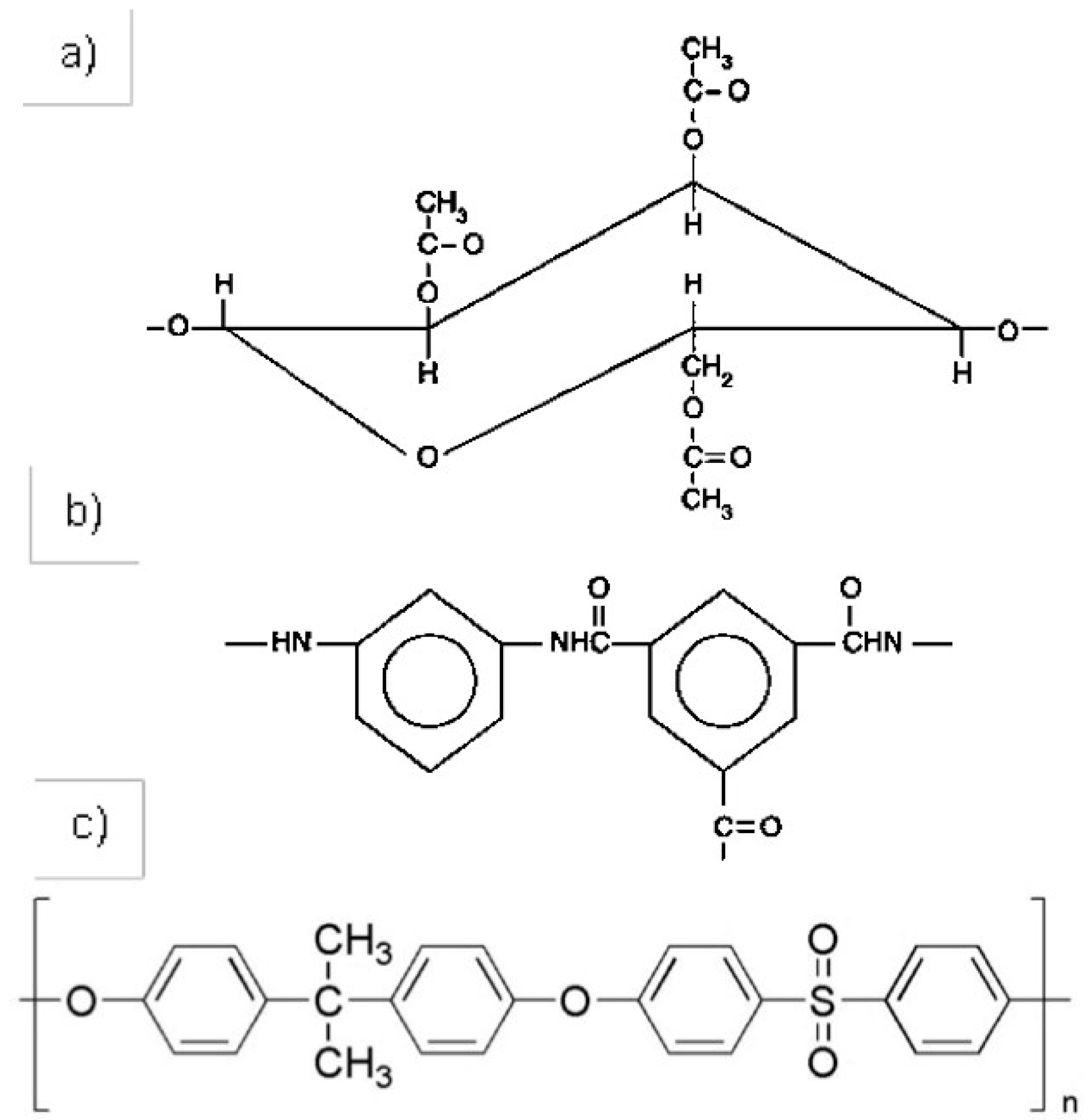
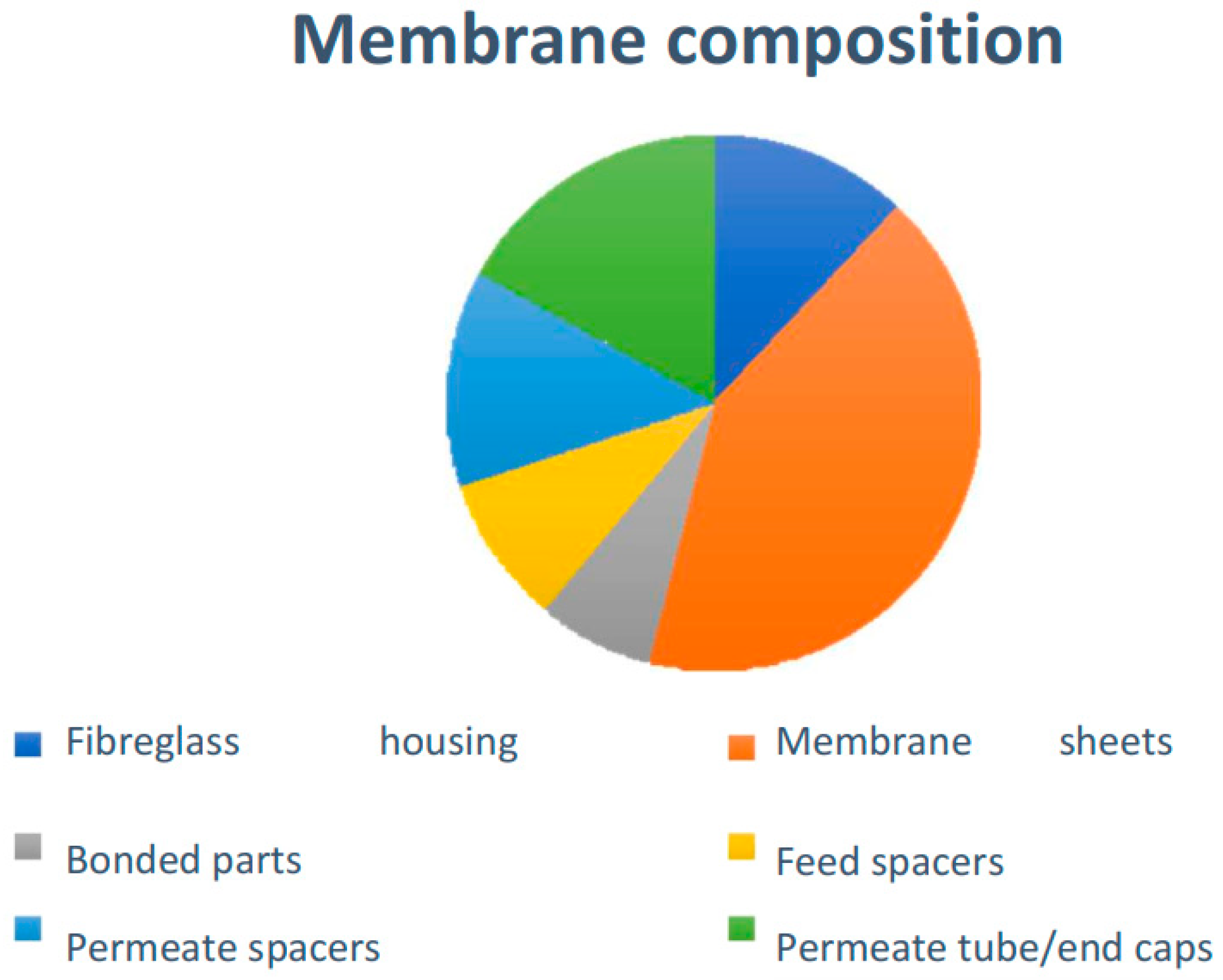
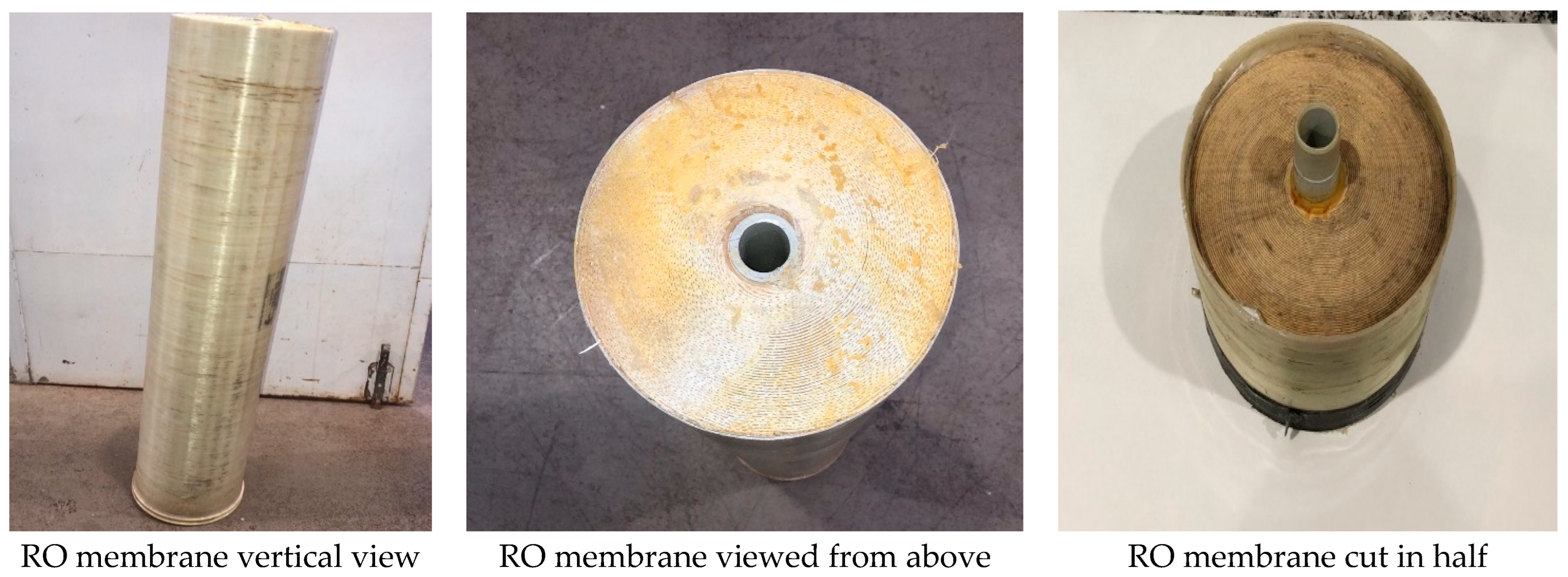
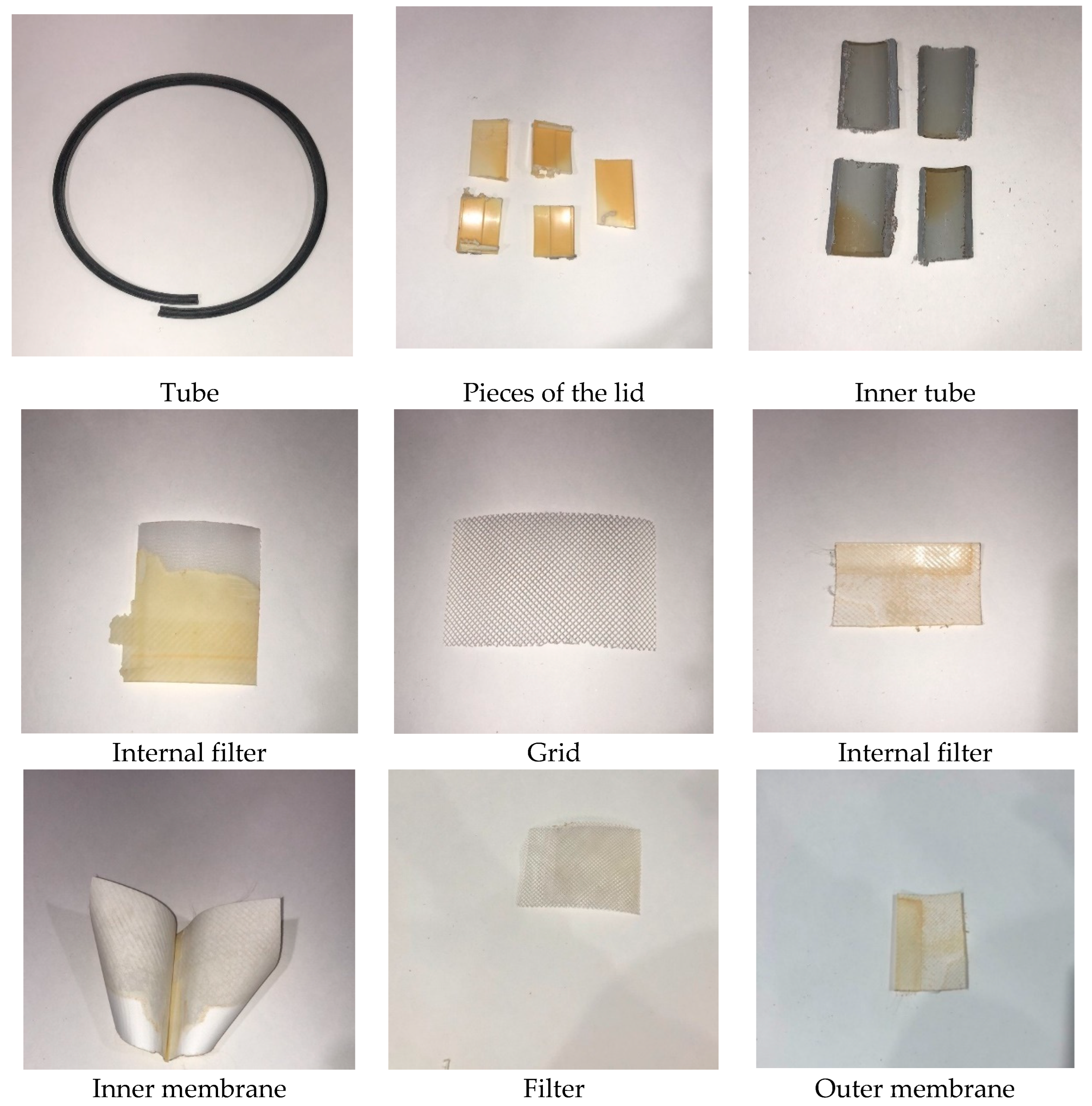
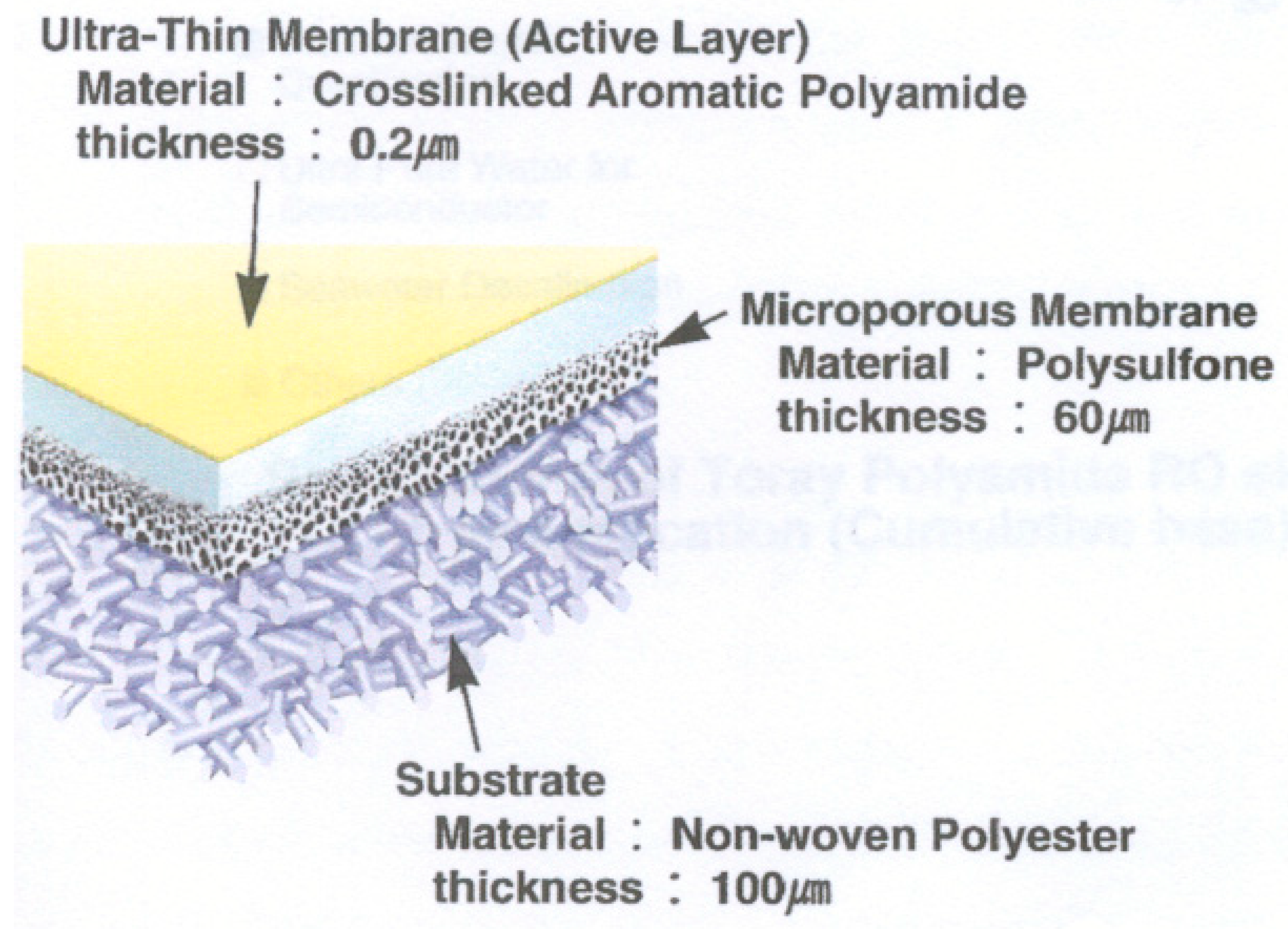
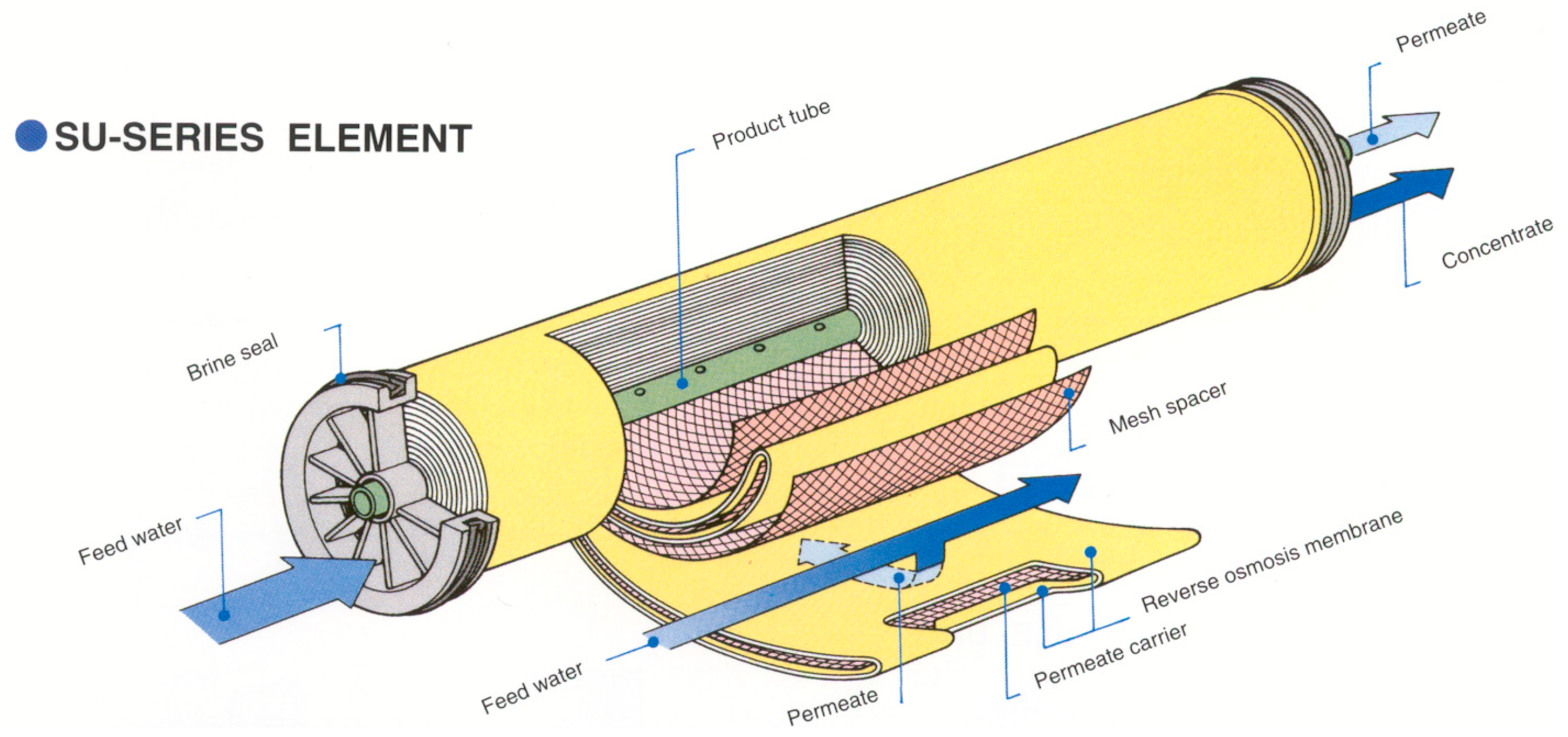
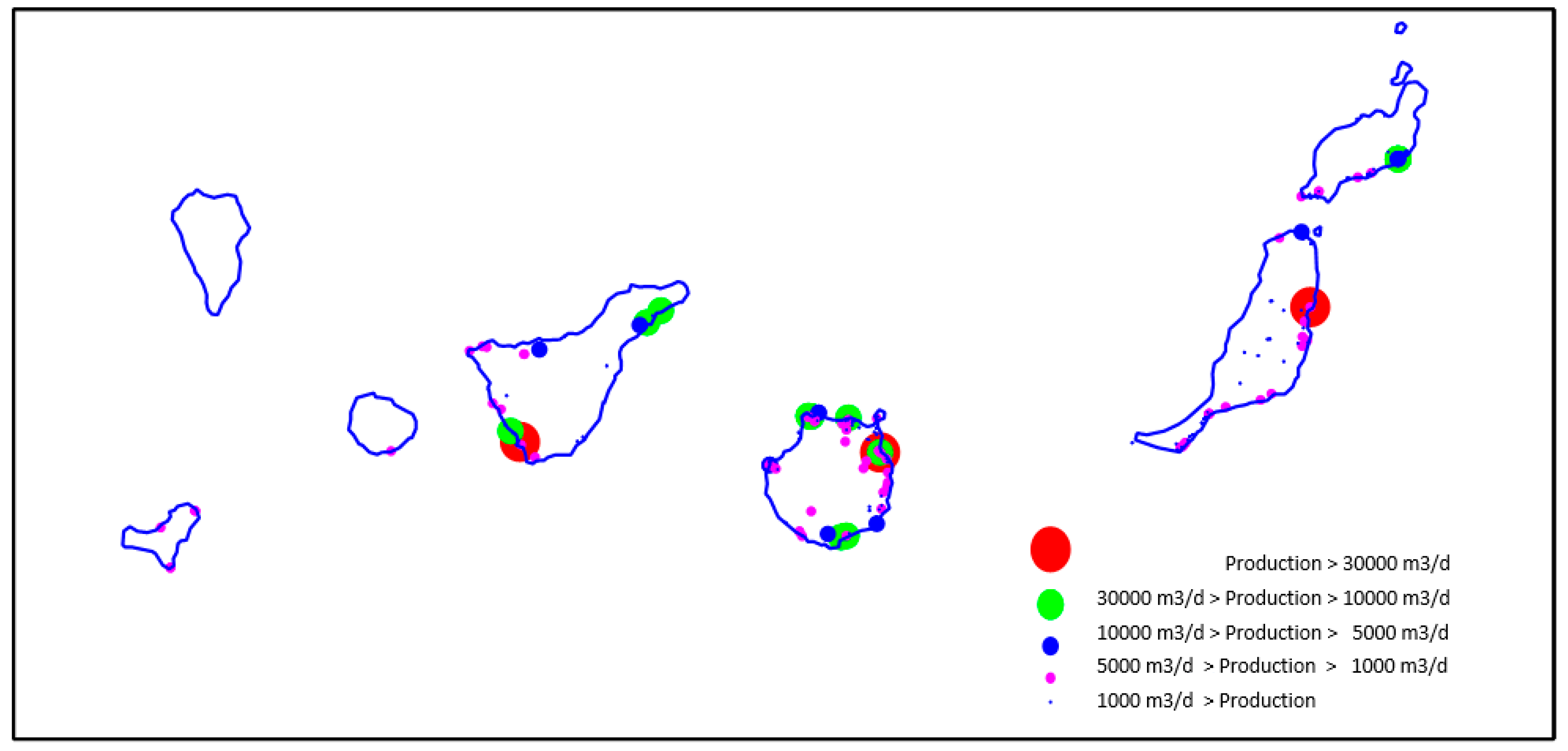
| Island | Nº. of Elements/Year Used | Element Replacement/Year |
|---|---|---|
| Gran Canaria | 23500 | 4700 |
| Tenerife | 9350 | 1870 |
| Fuerteventura | 8650 | 1730 |
| Lanzarote | 8000 | 1600 |
| Name of the Plant | Production (m3/d) | Consume (kWh/m3) | Island | Habitants per Plant |
|---|---|---|---|---|
| Cercado de Don Andrés | 200 | 3.5 | Lanzarote | Irrigation |
| Lanzarote III 1 | 10,000 | 3.5 | Lanzarote | 10541 |
| Lanzarote III 2 | 5000 | 3.5 | Lanzarote | 5271 |
| Lanzarote III 3 | 5000 | 3.5 | Lanzarote | 5271 |
| Lanzarote IV | 20,000 | 3.5 | Lanzarote | 21083 |
| Lanzarote V | 18,000 | 2.4 | Lanzarote | 18975 |
| Aeropuerto | 700 | 3.04 | Lanzarote | 18327 |
| Agua Park | 30 | 3.04 | Lanzarote | 500 |
| Apartamentos Ficus | 60 | 3.5 | Lanzarote | 120 |
| Apartamentos Puerto Tahiche | 150 | 3.5 | Lanzarote | 300 |
| Apartamentos Trebol | 80 | 3.5 | Lanzarote | 160 |
| Ercros | 2500 | 3.5 | Lanzarote | 11057 |
| Ercros | 2200 | 3.5 | Lanzarote | 9731 |
| Famara | 350 | 3.5 | Lanzarote | 700 |
| Hotel Golf y Mar | 90 | 3.5 | Lanzarote | 180 |
| Hotel Gran Meliá Salinas | 400 | 2.61 | Lanzarote | 800 |
| Hotel Playa Verde | 250 | 3.5 | Lanzarote | 500 |
| Hotel Teguise Playa | 250 | 3.5 | Lanzarote | 500 |
| La Galea | 150 | 3.04 | Lanzarote | 300 |
| Lanzarote Beach Club II | 70 | 3.04 | Lanzarote | 140 |
| Las Arenas. Costa Teguise | 80 | 3.04 | Lanzarote | 160 |
| Playa Roca | 250 | 3.04 | Lanzarote | 500 |
| Apartamentos Don Paco Castilla | 320 | 2.61 | Lanzarote | 640 |
| Apartamentos Sol Lanzarote | 350 | 2.61 | Lanzarote | 700 |
| Cdad Apartamentos CAMP | 2.61 | Lanzarote | Tourism | |
| Holiday Land S.A. | 3000 | 3.5 | Lanzarote | 6000 |
| Hotel Fariones Playa | 500 | 3.5 | Lanzarote | 1000 |
| Hotel Playa Azul | 300 | 3.5 | Lanzarote | 600 |
| Hoteles Canarios S.A. | 3.5 | Lanzarote | Tourism | |
| Iberhotel | 3.5 | Lanzarote | Tourism | |
| Zorilla | 40 | 3.04 | Lanzarote | 80 |
| Hotel Jameos Playa | 336 | 2.61 | Lanzarote | 672 |
| La Santa Sport I | 250 | 3.5 | Lanzarote | 500 |
| La Santa Sport II | 250 | 3.5 | Lanzarote | 500 |
| Ria La Santa | 400 | 3.5 | Lanzarote | 800 |
| Apartamentos Son Boy Family Suites | 500 | 3.04 | Lanzarote | 1000 |
| Bungalows Atlantic Gardens | 3.5 | Lanzarote | Tourism | |
| Costa los Limones S.A. | 350 | 3.5 | Lanzarote | 700 |
| Hotel Corbeta | 3.5 | Lanzarote | Tourism | |
| Hotel Costa Calero | 324 | 3.04 | Lanzarote | 642 |
| Marina Rubicón | 300 | 3.04 | Lanzarote | 600 |
| Hotel Paradise Island | 300 | 3.04 | Lanzarote | 600 |
| Hotel Princesa Yaiza | 500 | 3.04 | Lanzarote | 1000 |
| Hotel Rubicón Palace | 450 | 3.04 | Lanzarote | 900 |
| Inalsa Sur 1 | 600 | 3.5 | Lanzarote | 1859 |
| Inalsa Sur 2 | 1200 | 3.5 | Lanzarote | 3718 |
| Inalsa Sur 3 | 3000 | 3.5 | Lanzarote | 9294 |
| Janubio | 3.04 | Lanzarote | Tourism | |
| Lanzasur Club | 200 | 3.04 | Lanzarote | 400 |
| Playa Blanca S.A. | 3.5 | Lanzarote | Tourism | |
| Club Lanzarote | 4500 | 3.5 | Lanzarote | 9000 |
| Apartamentos Moromar | 250 | 3.5 | Lanzarote | 500 |
| Gea Fonds Numero Uno Lanzarote S.A. | 3.5 | Lanzarote | Tourism | |
| Grupo Rosa | 1000 | 3.5 | Lanzarote | 2000 |
| Hipotels | 300 | 3.5 | Lanzarote | 600 |
| Hotel Corona | 300 | 3.5 | Lanzarote | 600 |
| Hotel Costa Calero S.L. | 300 | 3.04 | Lanzarote | 600 |
| Hotel Sunbou | 500 | 3.04 | Lanzarote | 1000 |
| Isla Lobos | 100 | 3.04 | Lanzarote | 200 |
| Leas Hotel S.A. | 3.5 | Lanzarote | Tourism | |
| Niels Prahm | 3.5 | Lanzarote | Tourism | |
| Occidental Hotel Oasis | 250 | 3.04 | Lanzarote | 500 |
| Playa Flamingo | 200 | 3.04 | Lanzarote | 400 |
| Tjaereborg Timesharing. S.A. | 500 | 3.04 | Lanzarote | 1000 |
| Empresa Mixta de Aguas de Antigua. S.L. | 4800 | 3.04 | Fuerteventura | 11948 |
| Grupo Turístico Barceló. S.L. | 240 | 3.5 | Fuerteventura | 480 |
| Aguas Cristóbal Franquis. S.L. | 1200 | 3.5 | Fuerteventura | 2400 |
| Anjoca Canarias. S.A. | 3000 | 3.5 | Fuerteventura | 6000 |
| Ramiterra. S.L. | 3000 | 3.04 | Fuerteventura | 6000 |
| Inver Canary Dos. S.L. | 300 | 3.04 | Fuerteventura | 600 |
| Suministros de Agua de La Oliva. S.A. | 9000 | 3.04 | Fuerteventura | 17920 |
| Consorcio Abastecimiento de Aguas a Fuerteventura | 4000 | 3.04 | Fuerteventura | 7964 |
| Parque de Ocio y Cultura (BAKU) 1 | 300 | 3.04 | Fuerteventura | 600 |
| Parque de Ocio y Cultura (BAKU) 2 | 90 | 3.04 | Fuerteventura | 180 |
| RIU Palace Tres Islas | 100 | 3.5 | Fuerteventura | 200 |
| RIU Oliva Beach | 400 | 3.5 | Fuerteventura | 800 |
| Nombredo. S.L. | 500 | 3.5 | Fuerteventura | 1000 |
| Consorcio Abastecimiento de Aguas a Fuerteventura | 4400 | 3.5 | Fuerteventura | 20539 |
| Puertito de la Cruz | 60 | 3.5 | Fuerteventura | 120 |
| Vinamar. S.A. | 3600 | 3.5 | Fuerteventura | 7200 |
| Fuercan. S.L. Cañada del Rio I | 2000 | 3.5 | Fuerteventura | 4000 |
| Fuercan. S.L. Cañada del Rio II | 1000 | 3.04 | Fuerteventura | 2000 |
| Fuercan. S.L. Cañada del Rio III | 2000 | 3.04 | Fuerteventura | 4000 |
| Club Aldiana | 200 | 3.5 | Fuerteventura | 400 |
| Erwin Sick | 30 | 3.5 | Fuerteventura | 60 |
| Esquinzo Urbanización II | 1200 | 3.5 | Fuerteventura | 2400 |
| Esquinzo Urbanización III | 1200 | 3.5 | Fuerteventura | 2400 |
| Hotel Sol Élite Los Gorriones 1 | 400 | 3.5 | Fuerteventura | 800 |
| Hotel Sol Élite Los Gorriones 2 | 400 | 3.5 | Fuerteventura | 800 |
| Stella Canaris I | 300 | 3.5 | Fuerteventura | 600 |
| Stella Canaris II | 300 | 3.5 | Fuerteventura | 600 |
| Stella Canaris III | 250 | 3.5 | Fuerteventura | 500 |
| Hotel H 10 Playa Esmeralda. | 250 | 3.5 | Fuerteventura | 500 |
| Hotel “Club Paraíso Playa” | 300 | 3.5 | Fuerteventura | 600 |
| Urbanización Costa Calma. | 110 | 3.5 | Fuerteventura | 220 |
| Urbanización Tierra Dorada. | 120 | 3.5 | Fuerteventura | 240 |
| Zoo-Parque La Lajita. | 1300 | 3.5 | Fuerteventura | 500 |
| Apartamentos Esmeralda Maris | 120 | 3.5 | Fuerteventura | 240 |
| Hotel H10 Tindaya | 280 | 3.5 | Fuerteventura | 560 |
| Aparthotels Morasol | 80 | 3.5 | Fuerteventura | 160 |
| Consorcio Abastecimiento de Aguas a Fuerteventura | 36,500 | 3.5 | Fuerteventura | 39382 |
| Aeropuerto | 500 | 3.5 | Fuerteventura | 15439 |
| GranTarajal | 4000 | 3.5 | Fuerteventura | 14791 |
| Sotavento. S.A. | 2925 | 3.5 | Fuerteventura | 5850 |
| Arucas-Moya I | 10,000 | 3.5 | Gran Canaria | 45419 |
| Granja experimental | 500 | 3.5 | Gran Canaria | Irrigation |
| Granja experimental | 500 | 3.5 | Gran Canaria | Irrigation |
| Comunidad Fuentes de Quintanilla | 800 | 3.04 | Gran Canaria | Irrigation |
| Granja experimental | 500 | 3.5 | Gran Canaria | Irrigation |
| Gáldar-Agaete I | 3000 | 3.5 | Gran Canaria | 16199 |
| Gáldar II | 7000 | 3.04 | Gran Canaria | 37799 |
| Agragua | 15,000 | 3.5 | Gran Canaria | Irrigation |
| Guía I | 5000 | 3.5 | Gran Canaria | 6962 |
| Guía II | 5000 | 2.61 | Gran Canaria | 6962 |
| Félix Santiago Melián | 5000 | 2.61 | Gran Canaria | Irrigation |
| Las Palmas III | 65,000 | 3.5 | Gran Canaria | 307545 |
| Las Palmas IV | 15,000 | 2.61 | Gran Canaria | 70972 |
| BAXTER S.A. | 100 | 3.5 | Gran Canaria | 200 |
| El Corte Inglés. S.A. | 300 | 3.5 | Gran Canaria | 3000 |
| Anfi del Mar I | 250 | 3.5 | Gran Canaria | 500 |
| Anfi del Mar II | 250 | 3.5 | Gran Canaria | 500 |
| AQUALING | 2000 | 3.04 | Gran Canaria | 4000 |
| Puerto Rico | 4000 | 3.04 | Gran Canaria | 8000 |
| Puerto Rico I | 4000 | 3.04 | Gran Canaria | 8000 |
| Hotel Taurito | 400 | 3.04 | Gran Canaria | 800 |
| Hotel Costa Meloneras | 300 | 3.04 | Gran Canaria | 600 |
| Hotel Villa del Conde | 500 | 3.04 | Gran Canaria | 1000 |
| Bahia Feliz | 600 | 3.5 | Gran Canaria | 1200 |
| Bonny | 8000 | 3.5 | Gran Canaria | Irrigation |
| Maspalomas I Mar | 14,500 | 3.5 | Gran Canaria | 19572 |
| Maspalomas II | 25,200 | 3.04 | Gran Canaria | 34016 |
| UNELCO II | 600 | 3.5 | Gran Canaria | Industrial |
| Ayto. San Nicolas | 5000 | 3.04 | Gran Canaria | 7608 |
| Asociación de agricultores de la Aldea | 5400 | 3.04 | Gran Canaria | Irrigation |
| Sureste III | 8000 | 3.5 | Gran Canaria | 133846 |
| Aeropuerto I | 1000 | 3.5 | Gran Canaria | 24791 |
| Salinetas | 16,000 | 3.5 | Gran Canaria | 102424 |
| Aeropuerto II | 500 | 3.5 | Gran Canaria | 12396 |
| Hoya León | 1500 | 3.5 | Gran Canaria | Irrigation |
| Bco. García Ruiz | 1000 | 3.5 | Gran Canaria | Irrigation |
| Mando Aéreo de Canarias | 1000 | 3.5 | Gran Canaria | 3000 |
| UNELCO I | 1000 | 3.5 | Gran Canaria | Industrial |
| Anfi del Mar | 1500 | 3.04 | Gran Canaria | 3000 |
| Norcrost. S.A. | 170 | 3.04 | Gran Canaria | 340 |
| Adeje Arona | 30,000 | 3.04 | Tenerife | 126728 |
| Gran Hotel Anthelia Park | 3.04 | Tenerife | Tourism | |
| La Caleta (Ayto. Adeje) | 10,000 | 3.04 | Tenerife | 20000 |
| UTE Tenerife Oeste | 14,000 | 2.16 | Tenerife | 40000 |
| Hotel Sheraton La Caleta | 3.04 | Tenerife | Tourism | |
| Hotel Gran Tacande | 3.04 | Tenerife | Tourism | |
| Hotel Rocas de Nivaria. Playa Paraíso | 3.04 | Tenerife | Tourism | |
| Hotel Bahía del Duque. Costa Adeje | 3.04 | Tenerife | Tourism | |
| Siam Park | 3.04 | Tenerife | Tourism | |
| Tenerife-Sol S. A. | 3.04 | Tenerife | Tourism | |
| Hotel Conquistador. P. de Las Américas | 3.04 | Tenerife | Tourism | |
| Arona Gran Hotel. Los Cristianos | 3.04 | Tenerife | Tourism | |
| Bonny S.A. Finca El Fraile. | 3.04 | Tenerife | Tourism | |
| El Toscal. La Estrella (C. Regantes Las Galletas) | 3.04 | Tenerife | Tourism | |
| Complejo Mare Nostrum. P. Las Américas | 3.04 | Tenerife | Tourism | |
| Hotel Villa Cortés | 3.04 | Tenerife | Tourism | |
| Buenavista Golf S.A. | 3.04 | Tenerife | Tourism | |
| Rural Teno | 3.04 | Tenerife | Agrícola | |
| Ropa Rent. S.A. (P.I. Güímar) | 3.04 | Tenerife | Industrial | |
| Unelco | 600 | 3.5 | Tenerife | Industrial |
| I.T.E.R. Cabildo de Tenerife | 14 | 3.5 | Tenerife | Industrial |
| C.T. en P.I. de Granadilla | 3.5 | Tenerife | Industrial | |
| Bonny S.A. Finca El Confital. | 3.5 | Tenerife | Irrigation | |
| Polígono Industrial de Granadilla (portátil) | 3.5 | Tenerife | Industrial | |
| UTE Desalinizadora de Granadilla | 14,000 | 3.04 | Tenerife | 50146 |
| Guia de ISORA Hoya de la leña | 3.5 | Tenerife | Tourism | |
| Club Campo Guía de Isora. Abama | 3.5 | Tenerife | Tourism | |
| Hotel Meliá Palacio de Isora. Alcalá. | 3.5 | Tenerife | Tourism | |
| Loro Parque | 3.5 | Tenerife | Tourism | |
| Santa Cruz I | 20,000 | 3.04 | Tenerife | 204856 |
| Recinto Portuario Santa Cruz (portátil) | 3.04 | Tenerife | Industrial | |
| CEPSA | 1000 | 3.04 | Tenerife | Industrial |
| Hotel Playa la Arena | 3.04 | Tenerife | Tourism | |
| Hotel Jardín Tecina | 2000 | 3.04 | La Gomera | 4000 |
| La Restinga | 500 | 3.5 | El Hierro | 297 |
| La Restinga | 1200 | 3.04 | El Hierro | 712 |
| El Cangrejo | 1200 | 3.04 | El Hierro | 2478 |
| El Cangrejo | 1200 | 3.04 | El Hierro | 2478 |
| El Golfo | 1350 | 3.04 | El Hierro | 4093 |
| Macaronesia Islands | Number of Elements Used per Year | Partial Replacement per Year | Weight (kg) | Volume (m3) |
|---|---|---|---|---|
| Lanzarote (Canary Islands) | 8000 | 1600 | 32,000 | 67 |
| Fuerteventura (Canary Islands) | 8650 | 1730 | 34,600 | 73 |
| Gran Canaria (Canary Islands) | 23,500 | 4700 | 94,000 | 197 |
| Tenerife (Canary Islands) | 9350 | 1870 | 37,400 | 79 |
| El Hierro (Canary Islands) | 350 | 70 | 1400 | 3 |
| La Gomera (Canary Islands) | 150 | 30 | 600 | 1 |
| Porto Santo (Madeira) | 450 | 45 | 900 | 2 |
| Praia-Palmarejo (Cape Verde) | 700 | 100 | 2000 | 4 |
| St Vincent (Cape Verde) | 350 | 50 | 1000 | 2 |
| Salt (Cape Verde) | 350 | 50 | 1000 | 2 |
| TRADING ACCOUNT | YEAR 0 | YEAR 1 | YEAR 2 | YEAR 3 | YEAR 4 | YEAR 5 |
|---|---|---|---|---|---|---|
| Bills | 500 | 300 | 300 | 350 | 350 | |
| Variation of existences | 0 | 0 | 0 | 0 | 0 | |
| Shopping | 5000 | 3000 | 3000 | 3500 | 3500 | |
| External services | 1000 | 500 | 500 | 600 | 600 | |
| Personal expenses | 30,000 | 30,900 | 31,827 | 32,782 | 33,765 | |
| Amortization | 4000 | 4000 | 4000 | 4000 | 4000 | |
| Financial expenses | 100 | 100 | 100 | 120 | 120 | |
| Other expenses | 350 | 250 | 200 | 200 | 200 | |
| Total | 40,950 | 39,050 | 39,927 | 41,552 | 42,535 | |
| Income | 100,000 | 100,000 | 100,500 | 121,200 | 121,800 | |
| Variation of existences | 0 | 0 | 50 | 100 | 150 | |
| Sales (obsolete membranes) | 10,000 | 10,000 | 10,050 | 10,100 | 10,150 | |
| Other operating income | 0 | 0 | 0 | 0 | 0 | |
| Other income | 0 | 0 | 0 | 0 | 0 | |
| Financial income | 0 | 0 | 0 | 0 | 0 | |
| Total | −80,000 | 59,050 | 60,950 | 60,573 | 79,648 | 79,265 |
| Internal Rate of Returns (IRR) | 73% |
Publisher’s Note: MDPI stays neutral with regard to jurisdictional claims in published maps and institutional affiliations. |
© 2022 by the authors. Licensee MDPI, Basel, Switzerland. This article is an open access article distributed under the terms and conditions of the Creative Commons Attribution (CC BY) license (https://creativecommons.org/licenses/by/4.0/).
Share and Cite
Tavares, T.; Leon, F.; Vaswani, J.; Peñate, B.; Ramos-Martín, A. Study for Recycling Water Treatment Membranes and Compnents towards a Circular Economy—Case of Macaronesia Area. Membranes 2022, 12, 970. https://doi.org/10.3390/membranes12100970
Tavares T, Leon F, Vaswani J, Peñate B, Ramos-Martín A. Study for Recycling Water Treatment Membranes and Compnents towards a Circular Economy—Case of Macaronesia Area. Membranes. 2022; 12(10):970. https://doi.org/10.3390/membranes12100970
Chicago/Turabian StyleTavares, Tomás, Federico Leon, Jenifer Vaswani, Baltasar Peñate, and Alejandro Ramos-Martín. 2022. "Study for Recycling Water Treatment Membranes and Compnents towards a Circular Economy—Case of Macaronesia Area" Membranes 12, no. 10: 970. https://doi.org/10.3390/membranes12100970
APA StyleTavares, T., Leon, F., Vaswani, J., Peñate, B., & Ramos-Martín, A. (2022). Study for Recycling Water Treatment Membranes and Compnents towards a Circular Economy—Case of Macaronesia Area. Membranes, 12(10), 970. https://doi.org/10.3390/membranes12100970






